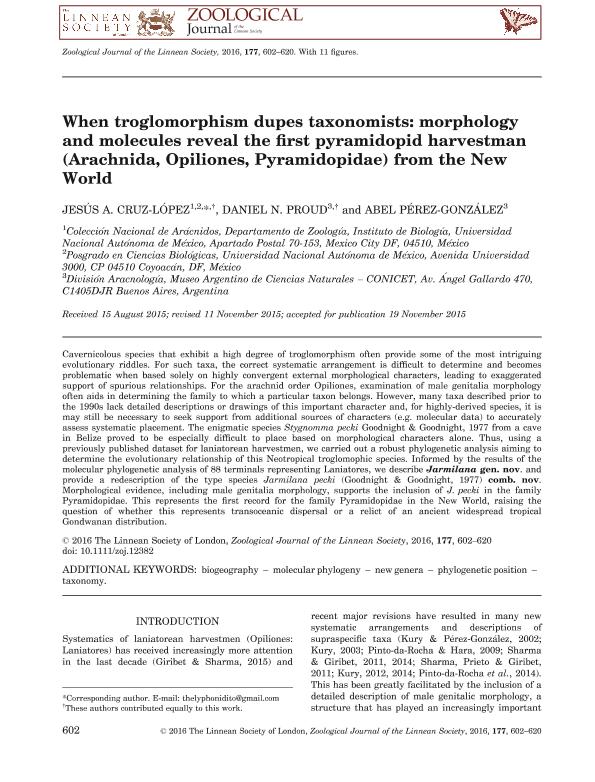Mostrar el registro sencillo del ítem
dc.contributor.author
Cruz López, Jesús A.
dc.contributor.author
Proud, Daniel Nathan

dc.contributor.author
Pérez González, Abel

dc.date.available
2019-10-02T20:50:24Z
dc.date.issued
2016-07
dc.identifier.citation
Cruz López, Jesús A.; Proud, Daniel Nathan; Pérez González, Abel; When troglomorphism dupes taxonomists: morphology and molecules reveal the first pyramidopid harvestman (Arachnida, Opiliones, Pyramidopidae) from the New World; Wiley Blackwell Publishing, Inc; Zoological Journal of the Linnean Society; 177; 3; 7-2016; 602-620
dc.identifier.issn
0024-4082
dc.identifier.uri
http://hdl.handle.net/11336/85077
dc.description.abstract
Cavernicolous species that exhibit a high degree of troglomorphism often provide some of the most intriguing evolutionary riddles. For such taxa, the correct systematic arrangement is difficult to determine and becomes problematic when based solely on highly convergent external morphological characters, leading to exaggerated support of spurious relationships. For the arachnid order Opiliones, examination of male genitalia morphology often aids in determining the family to which a particular taxon belongs. However, many taxa described prior to the 1990s lack detailed descriptions or drawings of this important character and, for highly-derived species, it is may still be necessary to seek support from additional sources of characters (e.g. molecular data) to accurately assess systematic placement. The enigmatic species Stygnomma pecki Goodnight & Goodnight, from a cave in Belize proved to be especially difficult to place based on morphological characters alone. Thus, using a previously published dataset for laniatorean harvestmen, we carried out a robust phylogenetic analysis aiming to determine the evolutionary relationship of this Neotropical troglomophic species. Informed by the results of the molecular phylogenetic analysis of 88 terminals representing Laniatores, we describe Jarmilana gen. nov. and provide a redescription of the type species Jarmilana pecki (Goodnight & Goodnight,) comb. nov. Morphological evidence, including male genitalia morphology, supports the inclusion of J. pecki in the family Pyramidopidae. This represents the first record for the family Pyramidopidae in the New World, raising the question of whether this represents transoceanic dispersal or a relict of an ancient widespread tropical Gondwanan distribution.
dc.format
application/pdf
dc.language.iso
eng
dc.publisher
Wiley Blackwell Publishing, Inc

dc.rights
info:eu-repo/semantics/openAccess
dc.rights.uri
https://creativecommons.org/licenses/by-nc-sa/2.5/ar/
dc.subject
BIOGEOGRAPHY
dc.subject
MOLECULAR PHYLOGENY
dc.subject
NEW GENERA
dc.subject
PHYLOGENETIC POSITION
dc.subject
TAXONOMY
dc.subject.classification
Zoología, Ornitología, Entomología, Etología

dc.subject.classification
Ciencias Biológicas

dc.subject.classification
CIENCIAS NATURALES Y EXACTAS

dc.title
When troglomorphism dupes taxonomists: morphology and molecules reveal the first pyramidopid harvestman (Arachnida, Opiliones, Pyramidopidae) from the New World
dc.type
info:eu-repo/semantics/article
dc.type
info:ar-repo/semantics/artículo
dc.type
info:eu-repo/semantics/publishedVersion
dc.date.updated
2019-10-02T14:27:43Z
dc.journal.volume
177
dc.journal.number
3
dc.journal.pagination
602-620
dc.journal.pais
Reino Unido

dc.journal.ciudad
Londres
dc.description.fil
Fil: Cruz López, Jesús A.. Universidad Nacional Autónoma de México; México
dc.description.fil
Fil: Proud, Daniel Nathan. Consejo Nacional de Investigaciones Científicas y Técnicas. Oficina de Coordinación Administrativa Parque Centenario. Museo Argentino de Ciencias Naturales “Bernardino Rivadavia”; Argentina
dc.description.fil
Fil: Pérez González, Abel. Consejo Nacional de Investigaciones Científicas y Técnicas. Oficina de Coordinación Administrativa Parque Centenario. Museo Argentino de Ciencias Naturales “Bernardino Rivadavia”; Argentina
dc.journal.title
Zoological Journal of the Linnean Society

dc.relation.alternativeid
info:eu-repo/semantics/altIdentifier/doi/http://dx.doi.org/10.1111/zoj.12382
dc.relation.alternativeid
info:eu-repo/semantics/altIdentifier/url/https://academic.oup.com/zoolinnean/article/177/3/602/2468525
Archivos asociados
